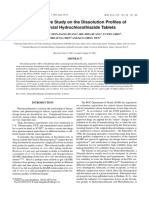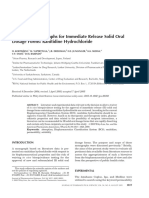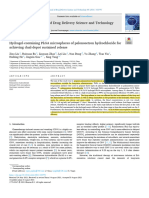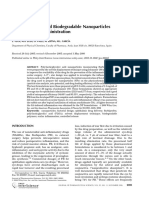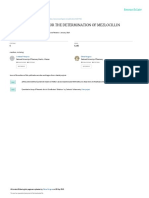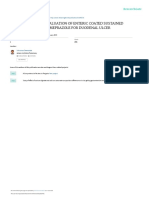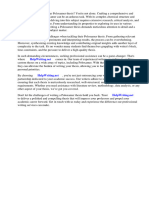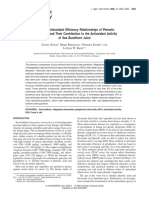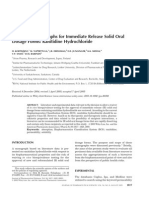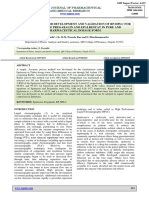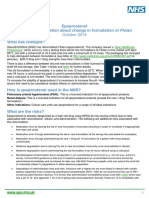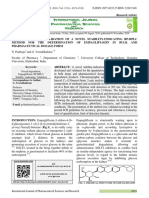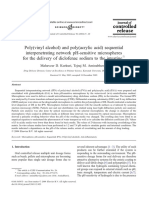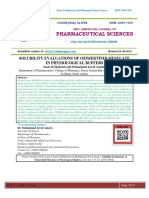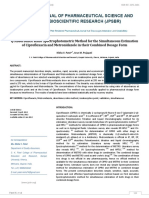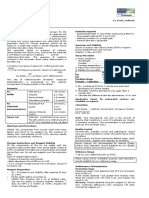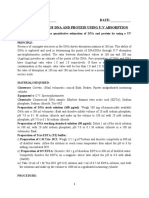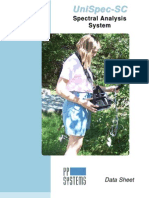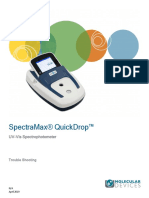Convolution Study On Lansoprazole Delayed-Release Capsules - Application of Similarity Factor To in - Vitro Dissolution
Convolution Study On Lansoprazole Delayed-Release Capsules - Application of Similarity Factor To in - Vitro Dissolution
Uploaded by
Anand UbheCopyright:
Available Formats
Convolution Study On Lansoprazole Delayed-Release Capsules - Application of Similarity Factor To in - Vitro Dissolution
Convolution Study On Lansoprazole Delayed-Release Capsules - Application of Similarity Factor To in - Vitro Dissolution
Uploaded by
Anand UbheOriginal Title
Copyright
Available Formats
Share this document
Did you find this document useful?
Is this content inappropriate?
Copyright:
Available Formats
Convolution Study On Lansoprazole Delayed-Release Capsules - Application of Similarity Factor To in - Vitro Dissolution
Convolution Study On Lansoprazole Delayed-Release Capsules - Application of Similarity Factor To in - Vitro Dissolution
Uploaded by
Anand UbheCopyright:
Available Formats
Chuong et al., IJPSR, 2015; Vol. 6(3): 1002-1012.
E-ISSN: 0975-8232; P-ISSN: 2320-5148
IJPSR (2015), Vol. 6, Issue 3 (Research Article)
Received on 20 July, 2014; received in revised form, 11 September, 2014; accepted, 01 December, 2014; published 01 March, 2015
CONVOLUTION STUDY AND THE ALCOHOLIC BEVERAGE EFFECT ON LANSOPRAZOLE
DELAYED-RELEASE CAPSULES AND APPLICATION OF SIMILARITY FACTOR TO TWO-
STAGE IN - VITRO DISSOLUTION PARADIGM
Monica C. Chuong *, Helal Alsulimani, Saheed Alabi, Nawaf Al-Saif, Sukran Damgali, Serkan Killioglu,
Steven La, Parth Patel, Dev Prasad, Jie Tan, Anand Ubhe, Jarred Uy, Michael Valladares, Loan Vo,
Mayura Wagle, Steven Crosby and Ahmed Mehanna
Department of Pharmaceutical Sciences, MCPHS University, Boston, MA, USA
Keywords: ABSTRACT: Lansoprazole, a proton pump inhibitor, is used to treat ulcers in
the stomach and duodenum. In order to protect this acid labile drug from being
Convolution, alcoholic beverage degraded in the gastric medium, the marketed oral dosage forms are formulated
effect, prodrug, Lansoprazole into delayed release pellets and tablets. The aims of this research were (1) to
Delayed-Release Capsules, FDA investigate the principal site of drug release and absorption rate between an over-
similarity factor f2 the-counter (OTC) product and a prescription brand, and (2) to explore the effect
Correspondence to Author: of ethanol on the in vitro release profile of the OTC product. For aim No. 1, the
Monica C. Chuong in vitro release profile conducted in our lab was convoluted with the
Department of Pharmaceutical lansoprazole plasma concentration time profile of an intravenous bolus reported
Sciences, MCPHS University 179 by Gerloff, et al. For aim No. 2, the dissolution of OTC capsules was studied
Longwood Ave, Boston, MA 02115, with 250 mL of 0.1 N HCl combined with equal volume of laboratory simulated
USA. beer and wine, which contained 5 and 11.5 % alcohol respectively to compare to
its reference, 0% (n=6). Furthermore, the dissolution of the OTC formulation in
E-mail: monica.chuong@mcphs.edu the simulated alcoholic beverage showed no difference between 5 %, 11.5 % and
0 % ethyl alcohol (n=8, U.S. FDA similarity factor, f2 > 50). We further explore
the explanation why in spite that the biological half-life of lansoprazole is only
1.1 h, the over the counter products are designed to dose once daily.
INTRODUCTION: Excessive acid secretion It is sparingly soluble in ethanol; and practically
exacerbates various gastrointestinal pathology insoluble in water 5. However, it has good
(peptic ulcer disease, gastroesophageal reflux permeability 6, 7. Therefore, according to the
disease, and Zollingger-Ellison syndrome) 1, 2, 3. Biopharmaceutical Classification System this drug
Exposure to stomach acid to the proximal small is classified as BCS Class II 8.
intestine also makes the area susceptible to develop The stability of lansoprazole decreases with the
ulcers, the duodenum's most common problem. increase in the acidity in an aqueous medium. At
Lansoprazole is classified as a proton pump 25°C the degradation half-life of lansoprazole is
inhibitor which blocks the H+/K+ ATPase in the about 0.5 hour in pH 5.0, while it half-life in pH
gastric parietal cell resulting in decreased acid 7.0 is 18 hours 9. This acid catalysis degradation of
secretion and allows the stomach and esophagus to proton pump inhibitors (PPIs) was established by
heal 4.
QUICK RESPONSE CODE
Lindberg et al in 1986 10. In the presence of proton
DOI: in the media, the basic nitrogen of the
10.13040/IJPSR.0975-8232.6(3).1002-12 benzimidazole ring become protonated and the acid
catalysis degradation takes place after 11. The rate
Article can be accessed online on: of the degradation depends on the level of the
www.ijpsr.com
proton or the acidity of the media. In couple of in
DOI link: http://dx.doi.org/10.13040/IJPSR.0975-8232.6(3).1002-12 vitro studies, Gupta et al. evaluated the rate of
International Journal of Pharmaceutical Sciences and Research 1002
Chuong et al., IJPSR, 2015; Vol. 6(3): 1002-1012. E-ISSN: 0975-8232; P-ISSN: 2320-5148
degradation of three PPIs including lansoprazole in product is manufactured by Novartis with a solo
buffer phosphate media with different pH ranges of strength of 15 mg in 14, 28 and 42 capsules per
3, 4, 5, 6 and 7.5, at 37 using differential pulse package 9, 13. Nowadays, there are three more OTC
polarography to quantify proton pump inhibitors lansoprazole 15 mg by DR REDDYS Labs Ltd,
and their degradation products in a current-time PERRIGO R&D, and WOCKHAR Ltd., available
manner. They found that as the pH of the medium in the market.
increases, the degradation rates of proton pump
inhibitors decrease. Also they found that Although the formulation is product specific, one
lansoprazole degraded at pH up to 6 while it was of the empirical formulations has been published 15.
stable at pH 7.5 11. Briefly described, lansoprazole was added into a
medium to spray coat on sugar spheres (Figure 1a
Due to the acid labile nature of lansoprazole, many & 1b). After being dried in the same spray coater,
commercial products are formulated as enteric- the drug beads were further enteric coated with
coated pellets (15 mg, 30 mg) byDR REDDYS methacrylic acid and polyacrylate 14 in the case of
Labs Ltd., MATRIX Labs Ltd., SANDOZ, Rx brand lansoprazole DR capsules and
TAKEDA Pharms NA, and TEVA Pharms. methacrylic acid copolymer in the case of OTC
TAKEDA Pharms NA, and TEVA Pharms also brand lansoprazole DR capsules (Figure 1c)
marketed this drug as DR orally disintegrating according to the ingredients listed in the package
tablets 12. In 2009, the only OTC lansoprazole inserts.
FIGURE1: EMPIRICAL FORMULATION PROCEDURE OF LANSOPRAZOLE DR 15 MG CAPSULES: (A)
SUGAR SPHERES, (B) DRUG LAYERED PELLETS, AND (C) ENTERIC COATED PELLETS 14.
Co administration of alcoholic beverage with some represents the spirit drink, resulted in six times
drug products including the modified release increase in mean Cmax in comparison to the control
formulations has been found can affect the release group who administered water (without 40%
properties of such products and eventually will alcohol). In one volunteer, there was about 16-fold
alter their bioavailability. In 2005, FDA withdrew rise in the Cmax observed. Co administration of 4%
one of the opiate controlled formulations, v/v alcohol drink resulted in twofold rise in Cmax in
Palladone TM, from the market due to a fatal some of the participants. Based on this possible
interaction with alcohol 15, 16. This product was interaction the FDA decided to develop regulatory
manufactured as a modified release pellets using decision framework to assess the risk of alcohol
ethyl cellulose, Eudragit RS (ammonia induced dose dumping for the oral MR products18.
methacrylate copolymer type B) and stearyl alcohol
17
. Routinely in vivo pharmacokinetics studies are not
easily feasible since it poses a chance of risk to the
A pharmacokinetic study conducted by the
participated patients in such clinical trials. Thus,
manufacture in which different concentrations of
alcohol were administered simultaneously with this the FDA necessitated the development of in vitro
studies to examine the vulnerability and ruggedness
extended release opiate pellet product in order to
of such MR formulations so that any defect could
explore the aforementioned fatal interaction. Co-
be circumvented at the early stage of the product
ingestion with 240 mL of 40% v/v alcohol, which
development. Therefore, in vitro dissolution studies
International Journal of Pharmaceutical Sciences and Research 1003
Chuong et al., IJPSR, 2015; Vol. 6(3): 1002-1012. E-ISSN: 0975-8232; P-ISSN: 2320-5148
can be used in this situation to explore the defect in mg) of lansoprazole reference standard was
the MR formulation coming from concomitant dissolved in 0.1 M HCl or phosphate buffer pH 6.8.
alcohol administration 18. Each medium contained 0.3% sodium dodecyl
sulfate based on the suggestion in the lansoprazole
Therefore, the overall project goal can be divided monograph. Samples were scanned using a UV-
into three aspects. First, it was to propose a three Vis Spectrophotometer from 190 nm to 700 nm to
pH stage study (0.1 M HCl, phosphate buffer pH identify the optimal wavelength at 285 nm.
4.0 and pH 6.5) to investigate lansoprazole 15 mg
DR capsules. The current USP-NF 19 guidelines Standard curve in each study medium which
were to test in 0.1 M HCl for 1 hr and then progress correlated between the responses of absorbance or
to phosphate buffer pH 6.8 for another hour. AUC to a series of known concentrations in the
Second, it was aimed to examine the OTC product working range (2, 8, 20, 40 μg/mL) was built. In
of lansoprazole 15 mg DR capsules would have addition to the acid stage medium (0.1 M HCl),
similar dissolution and simulated absorption profile Lansoprazole was spiked in three media to make
to the Rx lansoprazole 15 mg DR Capsules. In into four concentrations respectively to construct
order to achieve this aim,the USP dissolution standard curves. They were (1) lansoprazole in
apparatus 2, the U.S.FDA similarity factor (f2), phosphate buffer pH 6.8, (2) lansoprazole in
two-tail t-student test, lansoprazole IV plasma phosphate buffer pH 6.8 containing 5% alcohol and
concentration time data retrieved from the literature (3) lansoprazole in phosphate buffer pH 6.8
(30)and convolution study using Kinetica 2000 containing 11.5% alcohol. The standard
would have to apply. preparations were then quantified using UV
spectrophotometer as well as HPLC
Out of the general concern regarding the potential simultaneously.
effect of alcoholic beverage might alter drug
release from an oral formulation is, the third aim of The detection of the AUC in HPLC method and the
this project was to examine dissolution profile of absorbance in UV method were conducted in the
the OTC product containing alcohol vs. no alcohol. same wavelength, 285 nm to establish the
Two common alcoholic drinks are 5 % representing correlation between these two methods. The HPLC
beer and 11.5 % representing white and red conditions adopted from USP-NF 2014 20 were: (1)
wines20.Since we could not test all beer and wine acetonitrile, water, and triethylamin (40:60:1),
products available in the market, alcohol USPwas adjusted to pH 7.0 with phosphoric acid as the
used in our laboratory to prepare into simulated mobile phase, (2) 150 × 4.6 mm, 5 µm C18, 37oC
beer and wine. were the column type and temperature, (3) flow
rate 1.2 mL/min, (4) run time 10 min, (5) detecting
METHODS: wavelength 285 nm and (6) injection volume 50
Market products: microliters.
Prescription (Rx) Prevacid 15mg delayed-release
capsules (Takeda Pharmaceuticals) were ordered In vitro dissolution study: the USP two-stage and
from Cardinal Health (Dublin, OH) while OTC our proposed three-stage:
PREVACID 24 HR 15 mg (Novartis, lots 101493, In acid stage, each vessel of the USP dissolution
110158, 110179, 110538) was purchased from two apparatus 2 was filled with 500 mL of 0.1 N HCl
different local pharmacies in Boston, MA. preheated to 37oC19. One capsule of Prescription
(Rx) Prevacid15mg DR capsules (Takeda
Chemicals and reagents: Pharmaceuticals) or a capsule of OTC PREVACID
Lansoprazole USP (lot C142353) was ordered from PCCA
24 HR 15 mg 12
(Houston TX).
was Hydrochloric
loaded into the
acid
500
(HCl,
mL 36.5
of 0.1- 38%), ace
o
M HCl dissolution medium maintained at 37 C
Standard preparation to calculate the sample stirring at 75 rpm for 60 min. Eight mL of samples
concentrations: were collected at 20, 40 and 60 min for quantifying
Standard preparation was adopted from the USP37- the drug release in the acid stage. In buffer stage,
NF32 19. Briefly described, a known quantity (10 8.175 g of monobasic sodium phosphate, 3.525 g of
International Journal of Pharmaceutical Sciences and Research 1004
Chuong et al., IJPSR, 2015; Vol. 6(3): 1002-1012. E-ISSN: 0975-8232; P-ISSN: 2320-5148
sodium hydroxide, and 1.5 g sodium dodecyl Both were 15 mg in strength (n = 6) with the
sulfate were dissolved in deionized water to make plasma concentration time profile for IV bolus
into 0.5 L of buffer concentrate. Four hundred and administration retrieved from a publication of
twenty-five mL of this buffer was added to the Gerloff et al.25 (Figure 2).It was performed by
remaining 475 mL of acid stage solution, 0.1 N entering the cumulative drug release of in vitro
HCl, in each vessel with pH adjusted to 6.8, with dissolution of a study lansoprazole product into the
either phosphoric acid or sodium hydroxide. The OS (standing for by mouth) spreadsheet of the
apparatus operation condition 21-24 remained the software and the plasma concentration time profile
same as the acid stage (75 rpm, 37oC and 60 min) of lansoprazole intravenous bolus retrieved from
according to the USP dissolution guideline in the literature.
Lansoprazole monograph 19, but we voluntarily
increased the run time of the Rx product in the Alcoholic Beverage Effect on Lansoprazole DR
buffer stage for additional 60 min because the Capsules:
release was found not completed by the end of The USP dissolution apparatus 2 was used to study
buffer stage set by the compendium. the alcoholic beverage effect on the lansoprazole
release from its OTC brand of DR capsules.
The Acid stage preparation of our three stage in
vitro dissolution study was the same as the USP Medium preparations of laboratory simulated
Method. In Buffer stage 1, we added 125 mL of beer and wine:
simulated duodenum buffer concentrate which Alcohol USP of 13.16 mL was mixed with water to
contained 5.13 g tribasic sodium phosphate and make into 250 mL to simulate a glass of beer
1.5g of sodium dodecyl sulfate to the remaining (which contains 5% alcohol). Alcohol USP of
solution in the vessel of acid stage to bring pH to 30.26 mL was mixed with water to make into 250
4.5 and let the USP dissolution apparatus 2 stir at mL to mimic a cup of red or white wine (which
75 rpm for 15 min to simulate the retention time of contains 11.5% alcohol). 250 mL of water was
capsule pelletsin duodenum. In Buffer stage 2, 0.44 prepared to simulate the administration of a DR
g of NaOH was dissolved in 300 mL deionized capsule with water as the reference group. The
water to adjust dissolution medium to pH 6.5 to simulating beer, simulating wine or water of 250
simulate the jejunum environment and stirred at the mL was further mixed with 250 mL of 0.1 M HCl
same rate until all capsule pellets were dissolved. to load into a dissolution vessel of the USP
dissolution apparatus 2.
Convolution study:
Convolution program in Kinetica 2000TM (Inna The Acid stage study was then conducted at 75 rpm
Phase) was used to convolute the mean values of in with temperature maintained at 37oC and the
vitro dissolution data for the two commercial duration for 1 h. Eight mL of medium was
products: Rx Prevacid DR capsules and the OTC collected at 20 m 40 and 60 min with
PREVACID 24 HR. replenishment of fresh medium. The Buffer stage
medium preparation, operation condition, and
sampling time were the same as those described in
the Section 2.4: In vitro dissolution study.
U.S. FDA similarity factor, f2 value:
The FDA similarity factor f2 (Eq. 1) derived from
mean-squared difference is a measure of similarity
in the percentage dissolution between two
dissolution profiles 26. Thus, the similarity of two
dissolution profiles, administration of the OTC
FIGURE 2: PLASMA LEVELS OF LANSOPRAZOLE lansoprazole DR capsules with water versus with
(MEANS AND SD, N = 12) AFTER SINGLE DOSES OF an alcoholic beverage (test) at a particular time
15 mg IV BOLUS, 15 mg ORALLY AND 30 mg point can be determined.
ORALLY 25
International Journal of Pharmaceutical Sciences and Research 1005
Chuong et al., IJPSR, 2015; Vol. 6(3): 1002-1012. E-ISSN: 0975-8232; P-ISSN: 2320-5148
n
2
0.5
should be rejected when the f2 value is less than 50
f 2 50 log1 1 / n R T 100 26
.
t 1
(Eq. 1) RESULTS:
In vitro dissolution study: the USP two-stage vs.
Where f2 is similarity factor, our proposed three-stage: 2.46% of lansoprazole
n: time points, was released from a 15-mg Prevacid capsule in the
Acid stage and completely released (108.2%) in the
R: cumulative percent of the alcohol free sample as Buffer stage medium, pH 6.8 (n = 7, Figure 3a).
reference at the time point, Using our proposed three-stage method with four
T: cumulative percent of the alcoholic beverage sampling points: 30 min and 60 min in acidic stage,
(test) sample at the time point. 15 min at pH 4.5 and 15 min at pH 6.5, it was
found 2.77% of a 15 mg Prevacid capsule was
The f2 value is the average sum of squares of the released in acidic pH, while 94.9% was released in
difference between test and reference profiles and duodenum pH (pH 4.5) in 15 min, and the release
fits the result between 0 and 100. A critical value of was completed in jejunum pH (pH 6.5) within
50 is derived for similarity of dissolution profiles. additional 15 min (n = 6, Figure 3b). Since the
If the f2 value is between 50 and 100, this suggests proposal has not yet gained recognition by the
that the dissolution profiles are similar. A f2 value USP37-NF32, 2014 19, because only one
of 100 suggests that the test and reference releases pharmaceutical product (Prevacid 15 mg delayed-
are identical, and as the value becomes smaller the release capsule by Taketa) was studied, the present
dissimilarity between two release profiles project proceeded with the dissolution method
increases. Thus, the release from a test product listed in the compendium.
(a)
(b)
FIGURE 3: COMPARISON OF LANSOPRAZOLE RELEASE AT DIFFERENT LOCATIONS OF THE GASTROINTESTINAL
TRACT BETWEEN (a) THE USP TWO-STAGE DISSOLUTION METHOD 19AND (b) OUR PROPOSED THREE-STAGE
MODIFIED METHOD.
International Journal of Pharmaceutical Sciences and Research 1006
Chuong et al., IJPSR, 2015; Vol. 6(3): 1002-1012. E-ISSN: 0975-8232; P-ISSN: 2320-5148
The In vitro dissolution study between Rx and However, the drug release at the end of 1 h buffer
OTC products: stage study were 101.2 % ± 10.72 % for the OTC
The percentage dissolved versus time profile of Rx brand and 94.33 % ± 5.59 % for Rx brand. The
and OTC lansoprazole DR capsules products Buffer stage of the Rx brand was thus further
suggested that there was almost no drug release in extended for an additional hour and the drug
Acid stage as the dosage form designed for (1.21 % release was finally completed with the results of
± 1.14 % for OTC product and 2.82 % ± 1.74 % for 107.35 % ± 1.93 % (n = 6, Figure 4).
the Rx productat the end of one h, n = 6, Figure 5).
FIGURE 4: MEAN DISSOLUTION PROFILE OF 15 mg LANSOPRAZOLE Rx vs. OTC
Convolution Study:
of the Rx lansoprazole DR capsule, the Cmax would
The Convolution results conducted using Kinetica
reach 0.4µg/mL in about 1 hr 20 min (Figure 5a).
2000 software may be found in Table 1. The data
The maximal absorption rate of the Rx capsules
were further plotted into (a) plasma concentration
was 30.9 mg/h, while that of the OTC product was
time profiles, (b) rate of absorption vs. time profiles
predicted as 26.1 mg/h (Figure 5b).
for both OTC and Rx products. Convolution study
suggested that following a one-dose administration
TABLE 1: CONVOLUTION OUTPUTS OF KINETICA 2000 SOFTWARE, WHICH WAS DONE BY USING THE
CUMULATIVE DRUG RELEASE OF IN VITRO DISSOLUTION OF A STUDY LANSOPRAZOLE PRODUCT TO CONVOLUTE
THE PLASMA CONCENTRATION TIME PROFILE OF LANSOPRAZOLE IV BOLUS RETRIEVED FROM LITERATURE: (a)
OTC BRAND, AND (b) Rx BRAND
Tos A(t) Civ extra (Tos) dA/dt Cos
hr mg (mcg/ml) (mcg)/(hr) mcg/ml
0 0 0.452 0
0.33 0.22 0.352 0.667 0.008
0.67 0.19 0.228 -0.088 0.005
1.00 0.18 0.166 -0.030 0.003
1.33 8.80 0.138 26.121 0.303
1.67 12.42 0.101 10.647 0.357
2.00 15.18 0.067 8.364 0.358
Tos A(t) Civ extra (Tos) dA/dt Cos
hr mg (mcg/ml) (mcg)/(hr) mcg/ml
0 0 0.452 0
0.33 0.32 0.352 0.970 0.011
0.67 0.39 0.228 0.206 0.011
1.00 0.42 0.166 0.091 0.009
1.33 10.61 0.138 30.879 0.359
1.67 13.07 0.101 7.235 0.360
2.00 14.15 0.067 3.273 0.301
2.33 14.96 0.054 2.455 0.239
2.67 15.59 0.043 1.853 0.200
3.00 16.10 0.035 1.545 0.171
Tos: Time of oral administration;
A(t): Amount of drug absorbed;
Civ: Extrapolated IV Concentration at the time of oral administration;
dA/dt: Rate of absorption;
Cos: Concentration obtained by oral administration;
International Journal of Pharmaceutical Sciences and Research 1007
Chuong et al., IJPSR, 2015; Vol. 6(3): 1002-1012. E-ISSN: 0975-8232; P-ISSN: 2320-5148
(a)
(a)
(b)
(b)
FIGURE 5: CONVOLUTION PREDICTED PLASMA
CONCENTRATION TIME PROFILES AND
ABSORPTION RATES OF THE TWO STUDY
PRODUCTS. (a) After the Rx brand product and OTC
product being taken by mouth, the drug concentration of the
Rx brand product was predicted to reach its C max at 0.4
mcg/mL in about 1 h and 20 min, while the OTC product
reached its Cmax between 1 h 40 min to 2 h. (b) The maximal (c)
absorption rate was predicted as 30.9 mg/h for the Rx brand
and 26.1 mg/h for the OTC brand (see text)
Alcoholic beverage effect on Lansoprazole DR
capsules
Both 5% and 11.5% alcohol did not impact
lansoprazole release in acidic stage from its
delayed release capsule (Figure 6a). The in vitro
dissolution profiles indicated that lansoprazole was
released significantly different from the DR
Capsules into the simulated medium containing (d)
11.5% alcohol versus containing no alcohol (Figure FIGURE 6: TWO-STAGE IN VITRO DISSOLUTION
6b), but not those quantified by HPLC (Figure 6c), PROFILES OF LANSOPRAZOLE DR CAPSULES IN
(a) 5 % alcohol, containing (representing cup of beer) and
because both the drug and degradant absorbed alcohol-free media assayed by UV spectrophotometer, (b)
wavelength at 285 nm. The peak of the degradant 11.5 % alcohol-containing (representing a glass of wine) vs.
only appeared in high drug concentrations and the alcohol-free medium quantified by UV spectrophotometer, (c)
AUC of degradant was very small in comparison to 11.5 % alcohol-containing vs. alcohol-free medium quantified
the main drug peak (Figure 7). by HPLC, and (d) profiles from the same sample sets
quantified by UV versus by HPLC
International Journal of Pharmaceutical Sciences and Research 1008
Chuong et al., IJPSR, 2015; Vol. 6(3): 1002-1012. E-ISSN: 0975-8232; P-ISSN: 2320-5148
determine how to calculate the FDA similarity
factor in a DR dosage form. Should it be computed
(1) from Acid stage to Buffer stage, or (2) from
Buffer stage alone? When this equation was used to
conduct from Acid stage to Buffer stage, the f2
values for all profiles were above 50 suggesting the
release profiles were similar.
However, when the equation was used to conduct
the Buffer stage only (without the data from the
FIGURE 7: CHROMATOGRAM OF A LANSOPRAZOLE
DISSOLUTION SAMPLE SIMULATING THE Acid stage as they were almost no drug release in
ADMINISTRATION OF THE DRUG WITH A CUP OF this stage protected by the enteric coat), the f2
LABORATORY PREPARED WINE. THE RETENTION TIME value, 48.8 and 47.6 (< 50), the second column of
OF THE DRUG PEAK WAS 5 MIN WHILE AN
UNIDENTIFIED PEAK WAS ALSO PRESENT AT 9 MIN IN Table 2 from the right) indicated that the release
THE SAMPLES COLLECTED AT 60 MIN AND AFTER. THE profiles between the 11.5% alcohol vs. alcohol free
DEGRADANT PEAK WAS RATHER SMALL IN were different after being in Buffer stage for 20
COMPARISON TO THE MAIN DRUG PEAK.
min. The pellets were expected to transit through
The U.S. FDA similarity factor, f2 value: the duodenum and into the jejunum region. We
Since both the OTC and Rx products were DR oral further confirmed this finding by using t-test to
dosage form, there was almost no drug release in examine the release from time point by time point
the acid stage, we further used the dissolution data which aligned closer to the conclusion of the f2
of the in vitro dissolution study of OTC product in value computed from Buffer stage alone (the first
laboratory prepared alcohol beverage as the test two columns from the right of Table 2).
group and alcohol free as the reference group to
TABLE 2: THE FDA SIMILARITY FACTOR OF OTC AND RX DRUG PRODUCTS COMPUTATION DONE
FROM ACID STAGE TO BUFFER STAGE VERSUS THE BUFFER STAGE ONLY. THE RESULTS WERE
COMPARED TO THOSE OF T-TEST
Stage Cumulative Cumulative % of Release Similarity Factor (f2) P Value
Time (min)
11.5% EtOH No EtOH (n = 9) From Acid Buffer Stage
(n = 8) to Buffer Alone
Stages
Acid 20 1.3 2.45 91.1 Not Applied < 0.001*
40 1.4 2.44 91.4 Not Applied 0.007*
60 1.6 2.98 90.4 Not Applied 0.015*
Buffer 70 60.3 67.56 70.5 56.8 0.082**
(NS)
80 78.5 90.02 60.2 50.7 < 0.001**
100 85.5 97.58 56.1 48.8† < 0.001**
120 89.2 101.96 53.5 47.6† < 0.001**
† < 50 suggesting different profiles between the OTC brand and Rx brand
* Mann-Whitney Rink Sum Test;
** t-test;
NS: No Significant Difference
pathway is preferred not to take place before
DISCUSSION: Lansoprazole, an acid labile pro-
lansoprazole is absorbed into the blood stream. The
drug, prevents gastric acid secretion by selective
gastric juice is known rather acidic with the
covalent inhibition of H+/K+ ATPase, the last step
in acid secretary pathway. It needs the acid presence of abundant protons present. If
lansoprazole is released from its dosage form into
catalyzed reaction in order to convert to the active
the stomach, an undesired acid catalyzed reaction
form. This active entity will form a sulfide bond
may occur. That is, a proton will interact with the
with the active site of ATPase enzyme in the
basic nitrogen on the imidazole ring to form an
parietal cell 3, 29. However, this acid catalyzed
International Journal of Pharmaceutical Sciences and Research 1009
Chuong et al., IJPSR, 2015; Vol. 6(3): 1002-1012. E-ISSN: 0975-8232; P-ISSN: 2320-5148
intermediate compound which leads to the To assure the quality of the release profile,
formation of lansoprazole dimer. To prevent this dissolution studies are conducted and the FDA
interaction form occurring in the stomach, similarity factor f2 are compared. Also to make sure
lansoprazole is thus formulated as enteric coated that different brands of the same formulations can
beads with a pH sensitive polymer 9, 13-14. provide similar pharmacokinetic parameters such as
C max, t max and absorption profiles, these dissolution
But two questions related to formulation were raised experiments can provide a great insight to these
here. First, both Eudragit L100-55 and Eudragit parameters. We cannot say that the method that was
L100 17 have been used as enteric coating ingredient. advised by the USP to analyze the dissolution
As seen in Figure 1c, this pro-drug degraded linearly samples of lansoprazole by the UV
while the formation of dimer increased linearly when spectrophotometer is invalid just because the HPLC
it was allowed to be exposed to this pH 6.0 longer. gave us different or more accurate results. The
rational is that in the dissolution apparatus, these is
Therefore, Eudragit L100 (dissolution threshold at more chance for this pro-drug to degrade unlike what
pH 6.0) should be better than Eudragit L100-55 would happen in vivo.
(dissolution threshold at pH 5.5). Second, have the
commercial products been formulated into delayed In other words, lansoprazole is classified as class II
release followed by immediate release (DR-then-IR) drugs, which means it is going to be absorbed rapidly
or delayed release followed by extended release once it is released in the small intestine. As a result,
(DR-then-ER) based on the drug release pattern? the susceptibility of lansoprazole to breakdown in
Two reasons led us to believe that it is DR-then-ER vivo will be lower than in the in vitro dissolution
were (1) the biological half-life of lansoprazole is 1.1 study. That means less amount of its byproducts will
hr, (2) PREVACID 24 HR 15 mg is marketed for interfere with the UV reading. Therefore, UV is
once a day, the release is expected to be in aslow and suitable for quantifying the dissolution samples of
extended manner after the enteric coat is dissolved. this BCS class II drug. Our finding is consistent with
But Figures 2a and 2b suggest that lansoprazole was the analytical tool listed in Lansoprazole monograph
formulated as DR-then-IR based on the release of USP-NF 2014 19. However, ultra performance of
pattern. We further explored the rationale of making liquid chromatography (UPLC) would be an even
into DR-then-IR through literature search. better too if available.
Based on the study of Beel et al.30, once lansoprazole CONCLUSION: The project examined the
reaches the parietal cells from the systemic absorbance wavelengths of the two-phase in vitro
circulation, it will block the ATPase enzyme, thus dissolution study for lansoprazole and found 288 nm
reduce the secretion of protons into the stomach with was more sensitive than the 331 nm. Both
the half-life of 22 hr. Thus, it is reasonable to wavelengths are superior to 306 nm which is
fabricate the beads into DR-then-IR pattern instead suggested in USP-NF for the acid stage. Both our
of DR-then-ER by suspending lansoprazole in a study and the USP-NF 2013 agree that 285 nm is the
medium to spray on sugar spheres. Once dry, they suitable detecting wavelength for lansoprazole in the
were further coated with an enteric coat 14. buffer stage dissolution study. Correlating the
detective strength between ultraviolet/visual
Any small change in the formulation of such spectroscopy and HPLC showed linearity. However,
products could result in variation of the bio- UV spectrophotometer only reported the sum
pharmaceutical properties. Dissolution test is an absorbance of drug and its degradant, while HPLC
important tool to understand the release behavior of was able to quantify them individually. The two-
various pharmaceutical formulations and the effect stage in vitro drug release profiles between Rx and
of alcohol on these formulations 12, 17, 27, 28. The OTC lansoprazole products were compared. There
appropriate selection of an analytical method, such was almost no release between the two products in
as ultraviolet spectrophotometry or high performance the acidic stage, 0.1 N HCl (1.21±1.14% for OTC
liquid chromatography for in vitro dissolution study product and 2.82±1.74 for Rx brand, n = 6 each).
plays major role in the accuracy of the data. This finding adheres to the claim of the dosage form
International Journal of Pharmaceutical Sciences and Research 1010
Chuong et al., IJPSR, 2015; Vol. 6(3): 1002-1012. E-ISSN: 0975-8232; P-ISSN: 2320-5148
design as delayed release capsule. Nevertheless, assay. To avoid this problem, UPLC instead of
judging from the time course of in vitro dissolution HPLC should be tried in the future.
study and the convolution study combining the data
collected in the lab with the plasma concentration It should be noted that fermented alcoholic
time profile of the IV bolus retrieved from literature beverages, such as beer and wine, could increase
25
, the Rx release the drug slightly faster in the buffer gastric acid secretions 33. Therefore, peptic ulcer
stage reflecting that this product possibly was patients should avoid consumption of such
designed to target at the duodenum while the OTC beverages. Future study on whether higher alcohol
brand started drug release in duodenum and concentrations (such as two glasses or three glasses
completed its release in the proximal jejunum. of laboratory simulated wine) on lansoprazole DR
capsules may increase the chance of pre-drug release
The pharmacokinetic parameters that I obtained from in the stomach and result in drug inactivation should
convulsion study suggested that both products be conducted with an in vitro approach but not in
showed simulated plasma concentration peak that human subjects with the disease, because the
fell within the range of 1.5 to 2 h after ulcerative condition may be worsened.
administration. This finding is relevant to the range
that is obtained from the clinical studies conducted Last but not least, this project is insightful in gaining
by Freston JW et al. 31. the knowledge of pharmaceutical formulation.
Through the step-by step investigation of this dosage
In vitro dissolution study was conducted to examine form, the merit of making this pro-drug into DR-
the effect of coadministration of alcoholic beverage, then-IR beads were explored. We also comprehend
such as beer (containing 5% alcohol) or wine that although lansoprazole is more stable in pH 7.0,
(containing 11.5% alcohol), on the dissolution there is not much medium in the proximal colon for
properties of OTC enteric coated lansoprazole drug dissolution.
pellets. Our finding suggested that there was no
significant effect of the simulated cup of beer. The Therefore, targeting to the small intestine is
same study in the simulated wine quantified by UV appropriate in this case, because the drug absorption
showed the drug release in the alcohol-free medium is much effective in this region than in the colon due
was higher than the group in alcohol-containing to the presence of abundant microvilli. However, we
medium in the Buffer stage (Figure 7b), However, also identified a formulation drawback. From the
the same observation was not remarkable when the literature Eudragit L100-55 polymer was less
same sets of dissolution samples were quantified by favored than Eudragit L100 to be used in the
HPLC (Figure 7c). formulation work which dissolution threshold is pH
5.5 causing the conversion of lansoprazole into a
It was found that in addition of drug peak (which dimer more than that in pH 6.0. Since the dimer
retention time is 4.7 min in the stated HPLC cannot block the ATPase to reduce proton secretion,
method), there was an unidentified chromatographic the conversion may be reduced by properly selecting
peak (which retention time was 8.6 min) in both the Eudragit polymer in the subtype of L100.
alcohol-free and alcohol-containing groups. The
HPLC study proved that drug molecules and REFERENCES:
degradant molecules absorbed wavelength at 285 1. Spencer CM, Faulds D. Lansoprazole. A reappraisal of its
nm, which explained the difference in the study pharmacodynamic and pharmacokinetic properties, and its
therapeutic efficacy in acid-related disorders. Drugs1994;
results between UV and HPLC. The merit of HPLC 48(3):404-30.
is that it is a technology of better separation and Hatlebakk JG, Berstad A, Carling L, Svedberg LE, Unge P,
selection. However, the run time is longer (10 min Ekstrom P, Halvorsen L, Stallemo A, Hovdenak N, Trondstad
R, Kittang E, Lange OJ. Lansoprazole versus omeprazole in
per cycle in this case) than UV (5 sec in this case), short-term treatment of reflux oesophagitis. Results of a
when the study drug, lansoprazole, is degradable in Scandinavian multicentre trial. Scandinavian J
Gastroenterology1993; 28(3):224-8.
any proton containing medium, including phosphate 2. Ritter M, Lewis D, Mant K. A Textbook of Clinical
butter pH 6.8, degradation might continue during the Pharmacology. Arnold LTD, London 1999.
3. Page C, Curtis M, Sutter M, Walker M,Hoffman B. Drugs and
Gastrointestinal System, in Page C, Hoffman B, Curtis C and
International Journal of Pharmaceutical Sciences and Research 1011
Chuong et al., IJPSR, 2015; Vol. 6(3): 1002-1012. E-ISSN: 0975-8232; P-ISSN: 2320-5148
Walker M (eds): Integrated Pharmacology. Mosby, New 18. Lansoprazole Monograph. In: USP37 – NF32. USP
York, NY, Edition 3, 2006: 457-8. Convention, Inc., Rockville, MD 2014: 3499.
4. Budavari S. The Merck index: an encyclopedia of chemicals, 19. www.cedar-rapids.org/doing-business/licenses-permits-
drugs, and biological, Merck & Co., Inc., Whitehouse Station, taxes/PublishingImages/Beer_and_Wine.jp.Accessed 30 June
New Jersey2001: 961. 2013.
5. Delhotal Landes B, Petite JP, Flouvat B. Clinical 20. Moji CA, Harry GB. Dissolution Testing, in Preformulation in
pharmacokinetics of lansoprazole. Clinical Solid Dosage Form Development. Informa, New York,
Pharmacokinetics1995; 28(6):458-70. NY2008: 477-556.
6. Hussein Z, Granneman GR, Mukherjee D, Samara E, Hogan 21. Brown CK, Chokshi HP, Nickerson B, Reed RA, Rohrs BR,
DL, Koss MA, Isenberg JI. Age-related differences in the Shah PA. Acceptable analytical practices for dissolution
pharmacokinetics and pharmacodynamics of lansoprazole. testing of poorly soluble compounds. Pharmaceutical
British J Clinical Pharmacology1993; 36(5):391-8. Technology 2014; 28(12):56-65.
7. Guidance for industry extended release oral dosage forms, 22. Klein S. Dissolution Testing to Forecast the In Vivo
development, evaluation, and application of in vitro/in vivo Performance of MR Formulations, in Dressman JB. (ed), Oral
correlations. In: U.S. Dept. of Health and Human Services Drug Absorption. Informa Healthcare, New York, NY 2006:
FDA, Center for Drug Evaluation and Research, editor, 244-64.
MDRockville, 1997. 23. Gray V, Kelly G, Xia M, Butler C, Thomas S, Mayock S. The
8. PREVACID (lansoprazole) capsule, delayed release. science of USP 1 and 2 dissolution: present challenges and
http://dailymed.nlm.nih.gov/dailymed/lookup.cfm?setid=71ba future relevance. Pharmaceutical Research 2009; 26(6):1289-
78cb-7e46-43eb-9425-fa130f537f84.Accessed 30 June 2014. 1302.
9. Lindberg P, Nordberg P, Alminger T, Brändström A, 24. Gerloff J, Mignot A, Barth H, Heintze K. Pharmacokinetics
Wallmark B. The mechanism of action of the gastric acid and absolute bioavailability of lansoprazole. European J
secretion inhibitor omeprazole. J Medicinal Chemistry 1986; Clinical Pharmacology 1996; 50(4):293-7.
29(8):1328-9. 25. Shah, VP. The Role of Dissolution Testing in the Regulation
10. Gupta HP, Saini K, Dhingra P, Pandey R. Study of Acid of Pharmaceuticals: the FDA Perspective. Dissolution Method
Catalyzed Reactions of Proton Pump Inhibitors at D.M.E. Development with a View to Quality Control, in Dressman
PortugaliaeElectrochimicaActa2008: 26:433-48. JB, Kramer J (eds), Pharmaceutical Dissolution Testing.
11. FDA approved lansoprazole products. Informa Healthcare, New York, NY, 2005: 90-93, 335-336.
http://www.accessdata.fda.gov/scripts/cder/ob/docs/tempai.cf 26. Li S, He H, Parthiban LJ, Yin H, Serajuddin ATM. IV-IVC
m.Accessed 30 June 2014. considerations in the development of immediate-release oral
12. PREVACID 24 HR (lansoprazole) capsule, delayed dosage form. J Pharm Sci2005; 94(7):1396-417.
release.http://dailymed.nlm.nih.gov/dailymed/lookup.cfm?seti 27. Qiu Y, Samara EE, Cao G. In Vitro - In Vivo Correlations in
d=fd4629d5-b876-4ae9-bb32-c3560ad416a9.Accessed 30 the Development of Solid Oral Controlled Release Dosage
June 2014. Forms, in Wise D (ed), Handbook of Pharmaceutical
13. Young, CJ. Application of Powder Layering Technology and Controlled Release Technology. Marcel Dekker, New York,
aqueous Enteric Coating of Lansoprazole 15 mg Pellets. NY 2000: 528-32.
AAPS Annual Meeting, 2006. 28. Nagaya H, Satoh H, Kubo K, Maki Y. Possible mechanism for
14. 15.Teyssen S, Lenzing T, González-Calero G, Korn A, Riepl the inhibition of gastric (H ++K +)-adenosine triphosphatase
R.L., Singer M.V. Alcoholic beverages produced by alcoholic by the proton pump inhibitor AG-1749. J Pharmacology and
fermentation but not by distillation are powerful stimulants of Experimental Therapeutics 1989; 248(2):799-805.
gastric acid secretion in humans. Gut 1997; 40(1):49-56. 29. Bell N, Karol MD, Sachs G, Greski-Rose P, Jennings DE,
15. Meyer RJ, Hussein AS. Awareness Topic: Mitigating the risks Hunt RH. Duration of effect of lansoprazole on gastric pH and
of ethanol induced dose dumping from oral acid secretion in normal male volunteers. Alimentary
sustained/controlled release dosage forms. FDA's ACPS Pharmacology and Therapeutics 2001; 15(1):105-13.
Meeting, 2005. 30. Freston J.W., Chiu Y.L., Mulford D.J., Ballard Ii E.D.
16. EUDRAGIT® L 100 and L 100-55. Comparative pharmacokinetics and safety of lansoprazole oral
http://eudragit.evonik.com/product/eudragit/en/products- capsules and orally disintegrating tablets in healthy subjects.
services/eudragit-products/enteric-formulations/l-100- Alimentary Pharmacology and Therapeutics 2003, 17(3):361-
55/pages/default.aspx. Accessed 30 June 2014. 7.
17. U.S. Food and Drug Administration alert for healthcare
professionals. Alcohol-Palladone™ interaction,
2005.http://www.fda.gov/.Accessed 30 June 2014.
How to cite this article:
Chuong MC, Alsulimani H, Alabi S, Al-Saif N, Damgali S, Killioglu S, Steven La, Patel P, Prasad D, Tan J, Ubhe A, Jarred Uy,
Valladares M, Loan Vo, Wagle M, Crosby S and Mehanna A: Convolution Study And the Alcoholic Beverage Effect on Lansoprazole
Delayed-Release Capsules and Application of Similarity Factor To Two-Stage In - Vitro Dissolution Paradigm. Int J Pharm Sci Res
2015; 6(3): 1002-12.doi: 10.13040/IJPSR.0975-8232.6(3).1002-12.
All © 2013 are reserved by International Journal of Pharmaceutical Sciences and Research. This Journal licensed under a Creative Commons Attribution-NonCommercial-ShareAlike 3.0 Unported License.
This article can be downloaded to ANDROID OS based mobile. Scan QR Code using Code/Bar Scanner from your mobile. (Scanners are
available on Google Playstore)
International Journal of Pharmaceutical Sciences and Research 1012
You might also like
- G10&G10S Product Family Service ManualDocument135 pagesG10&G10S Product Family Service ManualPranish Pradhan100% (1)
- Method 18.0WDocument3 pagesMethod 18.0WVeronika RengganisNo ratings yet
- Chm580 Experiment 2Document8 pagesChm580 Experiment 2ohhi100% (1)
- _Roflumilast PDDocument8 pages_Roflumilast PDzcf86t6kx5No ratings yet
- Biowaiver Monographs IR DiclofenacDocument14 pagesBiowaiver Monographs IR DiclofenacserdaralpanNo ratings yet
- A Comparative Study On The Dissolution Profiles of Commercial Hydrochlorothiazide TabletsDocument7 pagesA Comparative Study On The Dissolution Profiles of Commercial Hydrochlorothiazide TabletsSami SamiNo ratings yet
- In Vitro Studies of Amlodipine Besylate Tablet and Comparison WithDocument7 pagesIn Vitro Studies of Amlodipine Besylate Tablet and Comparison WithBetty Wahyuning TiasNo ratings yet
- Verbeeck 2017Document35 pagesVerbeeck 2017giyan77No ratings yet
- A Novel Rapidly Disintegrating Tablet of Sildenafil Citrate With Enhanced Stability Design and Invitro EvaluationDocument12 pagesA Novel Rapidly Disintegrating Tablet of Sildenafil Citrate With Enhanced Stability Design and Invitro Evaluationzakarya wadiNo ratings yet
- Furosemide PDFDocument13 pagesFurosemide PDFariNo ratings yet
- Ranitidine HCLDocument9 pagesRanitidine HCLMochammad FerdiansyahNo ratings yet
- Article 7Document12 pagesArticle 7Dang Chi CongNo ratings yet
- ArticleText 183922 1 10 20200831Document10 pagesArticleText 183922 1 10 20200831exirraikaNo ratings yet
- Formulation and in Vitro Evaluation of Lansoprazole MicropelletsDocument11 pagesFormulation and in Vitro Evaluation of Lansoprazole MicropelletsVaibhavi JangdeNo ratings yet
- Zahra Ramadhani 2BDocument10 pagesZahra Ramadhani 2Bikhsan.230110080No ratings yet
- 4845-Article Text-28360-1-10-20150930Document4 pages4845-Article Text-28360-1-10-20150930Andika VarelNo ratings yet
- Latanoprostpaper 2014Document13 pagesLatanoprostpaper 2014ahmed.bouchenakNo ratings yet
- Journal of PharmaceuticalDocument13 pagesJournal of PharmaceuticaldwiNo ratings yet
- Iodometric Method For The Determination of Mezlocillin: ArticleDocument5 pagesIodometric Method For The Determination of Mezlocillin: ArticleAmaneNo ratings yet
- General Characteristics: AbsorptionDocument1 pageGeneral Characteristics: AbsorptionLenny NovitaNo ratings yet
- Monograph of Chloroquine PhosphateDocument7 pagesMonograph of Chloroquine PhosphateRisa DewiNo ratings yet
- Abendazol 2Document6 pagesAbendazol 2Agung WijayantoNo ratings yet
- Ibuprofen PH Solubility ProfileDocument12 pagesIbuprofen PH Solubility ProfileSondellNo ratings yet
- Development and Validation of A Simple and Rapid ICP-OES Method For Quantification of Elemental Impurities in Voriconazole Drug SubstanceDocument12 pagesDevelopment and Validation of A Simple and Rapid ICP-OES Method For Quantification of Elemental Impurities in Voriconazole Drug SubstanceDeepakrao Bornare PatilNo ratings yet
- Formulation and Evaluation of Enteric CoatedDocument13 pagesFormulation and Evaluation of Enteric Coatedvanvu buiNo ratings yet
- 2 CiprofloxacinDocument7 pages2 CiprofloxacinIlhan KhanNo ratings yet
- Quantitative Determination of Piperacillin by Iodometric Method Using Potassium PeroxomonosulfateDocument6 pagesQuantitative Determination of Piperacillin by Iodometric Method Using Potassium PeroxomonosulfateWSP ChanelNo ratings yet
- Floating Matrix Tablet ThesisDocument14 pagesFloating Matrix Tablet Thesisafktlrreerdihj100% (2)
- 463 PDFDocument4 pages463 PDFandypedeNo ratings yet
- DiclofenacDocument14 pagesDiclofenacAyunda Nur Faiz'zaNo ratings yet
- Poloxamer ThesisDocument9 pagesPoloxamer Thesisfjfcww51100% (1)
- Formulation Assignment InformationDocument12 pagesFormulation Assignment InformationLouisa WongNo ratings yet
- Structure Antioxidant Efficiency Relationships of Phenolic Compounds and Their Contribution To The Antioxidant Activity of Sea Buckthorn JuiceDocument7 pagesStructure Antioxidant Efficiency Relationships of Phenolic Compounds and Their Contribution To The Antioxidant Activity of Sea Buckthorn JuicejohnheverthNo ratings yet
- VygfDocument6 pagesVygfDyla FaradhylaNo ratings yet
- SynthesisDocument72 pagesSynthesisОливера СтојковићNo ratings yet
- Cut-Off Concentrations For Drugs of Abuse in Saliva For Dui, Dwi or Other Driving-Related CrimesDocument9 pagesCut-Off Concentrations For Drugs of Abuse in Saliva For Dui, Dwi or Other Driving-Related CrimesemmypuspitasariNo ratings yet
- Jurnal FurosemidDocument13 pagesJurnal FurosemidtyasulistNo ratings yet
- Sci Pharm: Release Kinetics of Papaverine Hydrochloride From Tablets With Different ExcipientsDocument14 pagesSci Pharm: Release Kinetics of Papaverine Hydrochloride From Tablets With Different ExcipientsSalazar I. JuanNo ratings yet
- Uhiuih With Cover Page v2Document10 pagesUhiuih With Cover Page v2fornctdream 02No ratings yet
- Penting BcsDocument26 pagesPenting BcsDEVIANo ratings yet
- 2013 Design and Development of Mucoadhesive Buccal Delivery For Pantoprazole With Stability Enhancement in Human SalivaDocument6 pages2013 Design and Development of Mucoadhesive Buccal Delivery For Pantoprazole With Stability Enhancement in Human SalivaGanesh BharskarNo ratings yet
- Ranitidine Hydrochloride PDFDocument9 pagesRanitidine Hydrochloride PDFDanisha LailaNo ratings yet
- Acid-Inhibitory Effects of Vonoprazan 20 MG ComparDocument12 pagesAcid-Inhibitory Effects of Vonoprazan 20 MG Comparjoydabnath67No ratings yet
- Analytical Method Development and Validation of RP-HPLC For Estimation of Pregabalin and Epalrestat in Pure and Pharmaceutical Dosage FormDocument10 pagesAnalytical Method Development and Validation of RP-HPLC For Estimation of Pregabalin and Epalrestat in Pure and Pharmaceutical Dosage FormSaravanan RamNo ratings yet
- PDF MPJ 1241Document14 pagesPDF MPJ 1241Sudheer K UnnithanNo ratings yet
- Broccoli Sulforaphane An Insight Into The Analytical Aspect and Uv Spectroscopic Method Development and ValidationDocument16 pagesBroccoli Sulforaphane An Insight Into The Analytical Aspect and Uv Spectroscopic Method Development and ValidationDuniaNo ratings yet
- Epoprostenol Important Information About Change in Formulation of FlolanDocument5 pagesEpoprostenol Important Information About Change in Formulation of FlolanNur FitrianaNo ratings yet
- Rabeprazole: A Pharmacologic and Clinical Review For Acid-Related DisordersDocument8 pagesRabeprazole: A Pharmacologic and Clinical Review For Acid-Related DisordersRabeprazole SodiumNo ratings yet
- 3732-Article Text-10547-1-10-20191123Document6 pages3732-Article Text-10547-1-10-20191123EDI SAPUTRANo ratings yet
- Research Paper Dynamic Dissolution Testing To Establish in Vitro/In Vivo Correlations For Montelukast Sodium, A Poorly Soluble DrugDocument8 pagesResearch Paper Dynamic Dissolution Testing To Establish in Vitro/In Vivo Correlations For Montelukast Sodium, A Poorly Soluble DrugronaldotimmNo ratings yet
- 29 Vol. 7 Issue 11 November 2016 IJPSR RA 6749Document8 pages29 Vol. 7 Issue 11 November 2016 IJPSR RA 6749manoj bhattaraiNo ratings yet
- 1 s2.0 S0168365904000057 MainDocument12 pages1 s2.0 S0168365904000057 MainRashmi RahagudeNo ratings yet
- Stability of Suspension Formulations of LansoprazoDocument7 pagesStability of Suspension Formulations of LansoprazoUmair MazharNo ratings yet
- 1258 1266lajp37761Document9 pages1258 1266lajp37761La Ai ToiNo ratings yet
- Development and Chemical Stability Studies of AlcoDocument6 pagesDevelopment and Chemical Stability Studies of AlcoMatei NarcisaNo ratings yet
- 22-Vol-13-Issue-6-Jun-2022-IJPSR-RA-16662Document14 pages22-Vol-13-Issue-6-Jun-2022-IJPSR-RA-16662drpierre.laboratoryNo ratings yet
- Development and Evaluation of Buccoadhesive Propranolol Hudrochloride Tablet Formulations Effect of FillersDocument7 pagesDevelopment and Evaluation of Buccoadhesive Propranolol Hudrochloride Tablet Formulations Effect of FillersCesar Rodolfo Angulo DelgadoNo ratings yet
- Solubility Evaluations of Osimertinib Mesylate in Physiological BuffersDocument6 pagesSolubility Evaluations of Osimertinib Mesylate in Physiological BuffersBaru Chandrasekhar RaoNo ratings yet
- Module 5Document41 pagesModule 5Logical ThinkerNo ratings yet
- Formulation and Evaluation of Prednisolone Sodium Phosphate InjectionDocument8 pagesFormulation and Evaluation of Prednisolone Sodium Phosphate InjectionMiranda MileNo ratings yet
- 1 s2.0 S221128631300002X MainDocument8 pages1 s2.0 S221128631300002X MainNataliya SlavovaNo ratings yet
- 8 Vol. 7 Issue 3 March 2016 IJPSR RA 59921Document11 pages8 Vol. 7 Issue 3 March 2016 IJPSR RA 59921DEVIANo ratings yet
- Dioxins and Health: Including Other Persistent Organic Pollutants and Endocrine DisruptorsFrom EverandDioxins and Health: Including Other Persistent Organic Pollutants and Endocrine DisruptorsNo ratings yet
- Insecticide Resistance Survey and TestingDocument8 pagesInsecticide Resistance Survey and TestingkhairilardhiNo ratings yet
- Basic UV-Vis Theory, Concepts and ApplicationsDocument28 pagesBasic UV-Vis Theory, Concepts and ApplicationsBroderick Mike100% (1)
- Densitometry and Spectrophotometr Y: Spectrophotometer ResponseDocument3 pagesDensitometry and Spectrophotometr Y: Spectrophotometer ResponseDiego FrancoNo ratings yet
- Q-Absorbance Ratio Spectrophotometric Method For The Simultaneous Estimation of Ciprofloxacin and Metronidazole in Their Combined Dosage FormDocument5 pagesQ-Absorbance Ratio Spectrophotometric Method For The Simultaneous Estimation of Ciprofloxacin and Metronidazole in Their Combined Dosage Formmahatir muhammadNo ratings yet
- Spectro PhotographyDocument5 pagesSpectro PhotographyStill HoppinNo ratings yet
- TAPPI T 618 cm-10Document6 pagesTAPPI T 618 cm-10T GadgilNo ratings yet
- Physical Tests / Á671ñ Containers-Performance Testing 1Document8 pagesPhysical Tests / Á671ñ Containers-Performance Testing 1RRR1No ratings yet
- Article 1437044786Document6 pagesArticle 1437044786mohdanasullahNo ratings yet
- Vol 4 Sec 3Document56 pagesVol 4 Sec 3Nur Aini IktikhafsariNo ratings yet
- Lipase Spinreact 1x24 ML, 1X48 MLDocument2 pagesLipase Spinreact 1x24 ML, 1X48 MLN. K. MandilNo ratings yet
- Analytical Instrumentation Questions and Answers - Infrared Gas AnalysersDocument4 pagesAnalytical Instrumentation Questions and Answers - Infrared Gas AnalysersMary Francia RicoNo ratings yet
- Lab Practical UGECBTP501 - FinalDocument38 pagesLab Practical UGECBTP501 - FinalkirshNo ratings yet
- Advance Analytical Course Prof. Padma Vankar Department of Chemistry Indian Institute of Technology, Kanpur Lecture No. # 31Document22 pagesAdvance Analytical Course Prof. Padma Vankar Department of Chemistry Indian Institute of Technology, Kanpur Lecture No. # 31Vignesh Raja PNo ratings yet
- Water-Soluble Vitamins With Minerals CapsulesDocument21 pagesWater-Soluble Vitamins With Minerals CapsulesWH PANDWNo ratings yet
- International Journal of Pharmtech ResearchDocument7 pagesInternational Journal of Pharmtech ResearchNovena sandraNo ratings yet
- Simple Spectrophotometric Method For The Determination of Aescin From Aesculus HippocastanumDocument4 pagesSimple Spectrophotometric Method For The Determination of Aescin From Aesculus Hippocastanumđảm bảo chất lượng thephacoNo ratings yet
- Analytical ToxicologyDocument51 pagesAnalytical ToxicologySomashekar ChandranNo ratings yet
- Optical Properties of Liquids For Direct Absorption Solar Thermal Energy SystemsDocument9 pagesOptical Properties of Liquids For Direct Absorption Solar Thermal Energy Systemsaun_nustNo ratings yet
- Spectral Analysis System UniSpec-SCDocument4 pagesSpectral Analysis System UniSpec-SCJuan Galindo Muñiz0% (1)
- URIT-8031 Operation Manual (2010)Document67 pagesURIT-8031 Operation Manual (2010)servidoresNo ratings yet
- 8 - Colorimetric Methods of AnalysisDocument59 pages8 - Colorimetric Methods of AnalysiskemtrunghaNo ratings yet
- Ibuprofen JP XVIIDocument2 pagesIbuprofen JP XVIIcamilo.carrilloNo ratings yet
- Xanthan Deacetylation PDFDocument6 pagesXanthan Deacetylation PDFdavsouNo ratings yet
- Microbiologist Techniques in MicrobiologyDocument61 pagesMicrobiologist Techniques in MicrobiologySruthy PBNo ratings yet
- Application of SpectrophotometerDocument16 pagesApplication of SpectrophotometerMuhammad RamzanNo ratings yet
- Spectramax Quickdrop Uv Vis SpectrophotometerDocument5 pagesSpectramax Quickdrop Uv Vis SpectrophotometerDeepakrao Bornare PatilNo ratings yet
- Manual Espectro N4SDocument49 pagesManual Espectro N4SAvril PacioNo ratings yet





